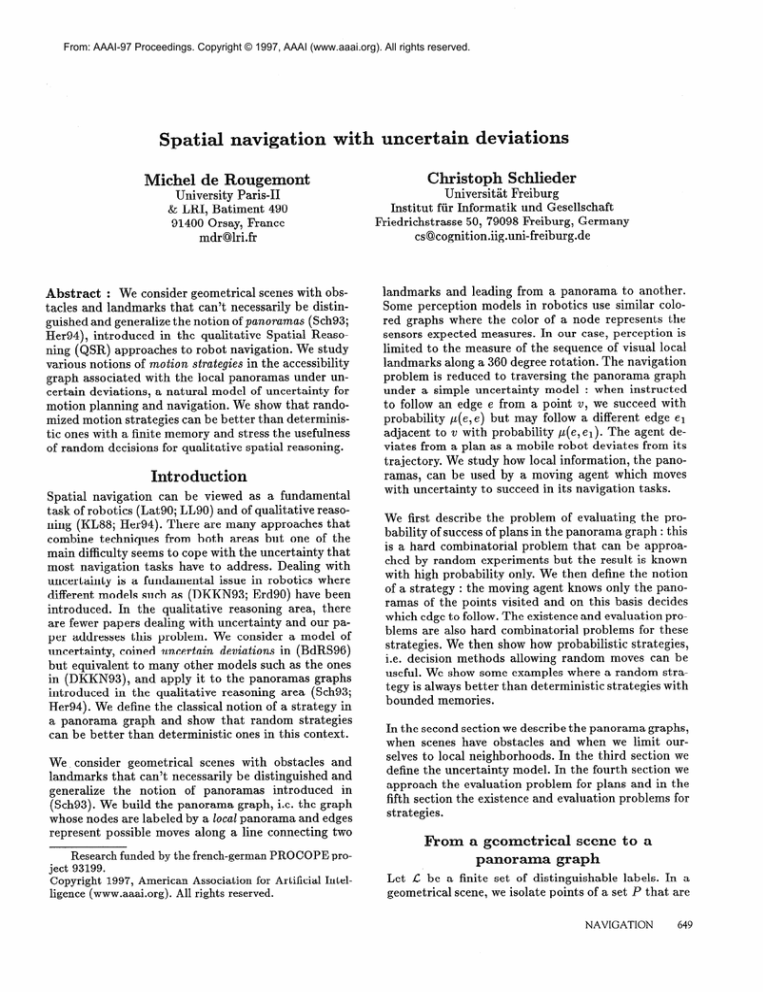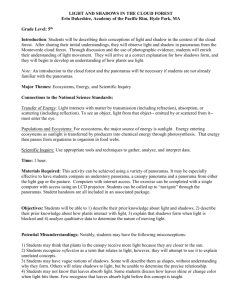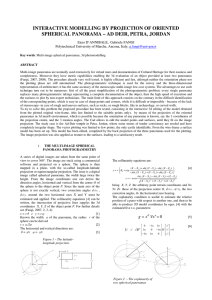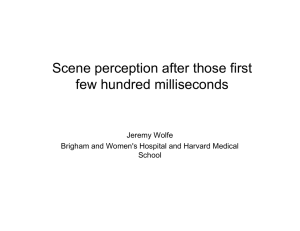
From: AAAI-97 Proceedings. Copyright © 1997, AAAI (www.aaai.org). All rights reserved.
Spat ial navigation
Michel
with
uncertain
Christ
de Rougemont
oph
Schlieder
Universitat
Freiburg
Institut
fiir Informatik
und Gesellschaft
Friedrichstrasse
50, 79098 Freiburg,
Germany
cs@cognition.iig.uni-freiburg.de
University
Paris-II
& LRI, Batiment
490
91400 Orsay, France
mdr@lri.fr
Abstract
: We consider geometrical
scenes with obstacles and landmarks
that can’t necessarily
be distinguished and generalize
the notion of panoramas
(Sch93;
Her94),
introduced
in the qualitative
Spatial
Reasoning (QSR) approaches
to robot navigation.
We study
various notions of motion strategies in the accessibility
graph associated
with the local panoramas
under uncertain deviations,
a natural
model of uncertainty
for
motion planning
and navigation.
We show that randomized motion strategies
can be better than deterministic ones with a finite memory and stress the usefulness
of random
decisions for qualitative
spatial reasoning.
Introduction
Spatial
navigation
can be viewed
as a fundamental
task of robotics
(Lat90; LL90) and of qualitative
reasoning (KL88;
Her94). There are many approaches
that
combine
techniques
from both areas but one of the
main difficulty
seems to cope with the uncertainty
that
most navigation
tasks have to address. Dealing
with
uncertainty
is a fundamental
issue in robotics
where
different
models such as (DKKN93;
Erd90) have been
introduced.
In the qualitative
reasoning
area, there
are fewer papers dealing with uncertainty
and our paper addresses this problem.
We consider
a model of
uncertainty,
coined uncertain
deviations
in (BdRS96)
but equivalent
to many other models such as the ones
in (DKKN93),
and apply it to the panoramas
graphs
introduced
in the qualitative
reasoning
area (Sch93;
Her94). We define the classical notion of a strategy in
a panorama
graph and show that random
strategies
can be better than deterministic
ones in this context.
We consider
geometrical
scenes with obstacles
and
landmarks
that can’t necessarily
be distinguished
and
generalize
the notion
of panoramas
introduced
in
(Sch93). We build the panorama
graph, i.e. the graph
whose nodes are labeled by a local panorama
and edges
represent
possible
moves along a line connecting
two
landmarks
and leading from a panorama
to another.
Some perception
models in robotics
use similar
colored graphs where the color of a node represents
the
sensors expected
measures.
In our case, perception
is
limited
to the measure of the sequence of visual local
landmarks
along a 360 degree rotation.
The navigation
problem
is reduced to traversing
the panorama
graph
under a simple uncertainty
model : when instructed
to follow an edge e from a point v, we succeed with
probability
p(e) e) b u t may follow a different
edge ei
adjacent
to v with probability
p(e,er).
The agent deviates from a plan as a mobile robot deviates from its
trajectory.
We study how local information,
the panoramas, can be used by a moving
agent which moves
with uncertainty
to succeed in its navigation
tasks.
We first describe
the problem
of evaluating
the probability
of success of plans in the panorama
graph : this
is a hard combinatorial
problem
that can be approached by random
experiments
but the result is known
with high probability
only. We then define the notion
of a strategy : the moving agent knows only the panoramas of the points visited and on this basis decides
which edge to follow. The existence and evaluation
problems are also hard combinatorial
problems
for these
strategies.
We then show how probabilistic
strategies,
i.e. decision methods
allowing
random
moves can be
useful. We show some examples where a random
strategy is always better than deterministic
strategies with
bounded
memories.
In the second section we describe the panorama
graphs,
when scenes have obstacles
and when we limit ourselves to local neighborhoods.
In the third section we
define the uncertainty
model. In the fourth section we
approach
the evaluation
problem
for plans and in the
fifth section the existence and evaluation
problems
for
strategies.
Ek0m
Research
funded
by the french-german
PROCOPE
ject 93199.
Copyright
1997,
American
Association
for Artificial
ligence
(www.aaai.org).
All rights
reserved.
deviations
proIntel-
a geometrical
panorama
scene
graph
to a
Let C be a finite set of distinguishable
labels. In a
geometrical
scene, we isolate points of a set P that are
NAVIGATION
649
possible
landmarks
with
a label
2 E C, and a function:
L:P+C
Two landmarks
with the same label can’t be distinguished, as two corners in a room or two doors. Consider
the standard
cellular decomposition
associated
with P
and its panorama-graph
as in (Sch93) : nodes represent
regions of the cellular
decomposition
labeled by their
panoramas,
the sequence of landmark’s
labels along a
360 degree rotation
taking the directions
into account.
Edges represent
possible transitions
between adjacent
regions. Two cases can be considered,
as illustrated
by
the figures 1 and 2 :
e
The case
visible.
of global
visibility
: all landmarks
are
0
The case of local
visibility
: only visible landmarks contribute
to the cellular
decomposition,
i.e.
for two landmarks
A and B, the segment supporting
(AB) does not intersect
any obstacles.
ding visible landmarks
as long
as no obstacles
are crossed. Let G be the local panorama
graph, i.e. the graph
where a point is a region pi and D, = {rl,rz,
. . . ..rn}
is the domain
of the graph. Nodes of the graph are
colored with their panoramas.
Let us call p(~i) the panorama of the point ri and P the set all panoramas.
An edge between two adjacent
regions is labeled with
(A, B), where A, B E ,C if the two regions
are adjacent
along a segment
supported
by landmarks
pi and pj
such that L(pi) = A and L(pi) = B. Let the function
label
defined as
label
:
D, x D, + l x fT
be the partial
function
which associate
labels to the edges. The label function
tric
in the sense that if labeE(ri,rj)
=
the correct
is symrne(A, B), then
ZabeZ(rj, ri) = (B, A).
The panorama
graph or P-graph
is : G = (D,,p, label)
where D, is the domain,
p the panorama
function
which associates a panorama
with every point of the
domain, and label the previous function.
figure
3 below,
the PExample
: For the geomet,rical
graph
(wit.hout
the labels
on the nodes
and the edges)
is shown
in figure
4. Notice
that
the obstacle
‘Is corners behave
like landmarks
for the local cell decomposit ions.
Fig. 1 Global
Example
at, position
:
panorama
,C = (N,
1 is :
S, W, E).
Fig. 2
Local
The
global
panorama
panorama
SNwEWeNSsnWewEns
VVe start
wit.h the S landmark
on the western
side and
encount.er
N then
w (the sout.hern
W landmark
from
the back,
hence
writt,en
with
a small
letter),
t.hen E
and so on. Notice
that. each landmark
occurs
twice,
once forward
wit,h a capit,al
letter
and once backwards
wit.h a small
let.t.er.
The panorama
at. posit.ion
1 is a
sequence
of 16 labels.
At. posit,ion
2, the global
panorama
is ; SNEwWeNSsneWwEns.
If all landmarks
were
distinct.,
all panoramas
would
be distinct..
Because many
landmarks
can not, be distinguished,
some
panoramas
will be identical.
The
local
panoramas
of 6he same
configuration
of
landmarks
in a room
wit.h
an obst,acle
are illustrated in figure
2. Note
that although
the landmarks
are
not uniquely
ident,ified,
it. is possible
60 dist.inguish
t,he exits
by their
local
panoramas
: t,he position
3
(northern
exit. in figure
2) is labeled
: EWew
whereas
the posit.ion
4 (southern
exit, in figure
2) is labeled
:
WEwe.
We consider
composition
650
the case of local
is the geometrical
PERCEPTION
& BEHAVIOR
visibility
and the cell descene with a line exten-
Fig. 3
Square room
Fig. 4 P-graph
ode1 of uncertainty
To model the uncertainty,
we introduce
the deviation
function
p on the set of edges E of the P-graph.
The
set E is the subset of pairs of D, x D, for which the
function
Eabel is defined.
p : E x E + [0, l]
The function
/J is defined
for pairs of edges with a
common
tail. If e and el do not have a common
tail,
p(e, el) = 0. Let e = (W,UI) be an edge to follow. The
motion will be along the edge el = (w, U) with the probability
p(e, el), and the vertex w will be reached only
with the probability
p(e, e). We assume that
):
el GOUT(v)
P(e,el)
=
1,
i.e. that one of the possible
movements
(OUT(V)
is the set of edges whose tail is
bability
space is the set of nodes adjacent
consider the probability
distribution
p as
We may then study special cases where this problem
can be computed
in polynomial
time (MdRR94)
or directly deal with the more general notion of a strategy.
takes place
v). The proto v and we
given.
Motion
This model of uncertainty
is natural
for navigation
and
motion planning
: a moving agent always deviates from
an original route and one can reasonably
say that the
deviations
are probabilistic.
The colorings of the nodes
model the points that can be distinguished
by the panoramas.
In a physical
model, the sensors would give
the panoramas
(possibly
with some approximation).
The evaluation
of plans
Let G be a P-graph,
p the uncertainty
function
and
two points s,t E D,. We wish to navigate
from s to
reach t. Given (D,,p, label, CL,s, t), a plan is a path
connecting
s to t in G.
DeAnition
2 A strategy is a function
CTwhich assigns
to a finite sequence of panoramas
(the history
of the
perception
of the visited points) an edge label describing
uniquely
the edge to follow.
Definition
1 A plan 7r =<
II, . . . . II, > is a sequence of edge labels connecting
s to t. A possible
path CT is a sequence s = v~,vI,. . . ,vi, . . . . vg such that
p( (vi--1,v&
e;) # 0 w h ere ed is the edge whose label is
iv
A possible path is simply the execution
of a plan under the probabilistic
model. The probability
associated
with a possible path cr and a plan K is
Prob(a
/ n) = fi
Prob(((vi-1,
vi) / li) = p((vi-l,vi),
i=l
if ei is the edge whose label is li. Let CONE(n)
the set
of possible paths. The probability
to reach t starting
in s is the probability
that 7r succeeds.
Prob[n
where
succeeds]
=
):
cc6 . IProb(o,z-)
cTECONE(7r)
t and 0 otherwise.
2, = 1 if cr reaches
Given a plan, we can ask how to evaluate
its reliability, i.e. the probability
it will succeed. We deal with
the decision problem
:
Evaluation
tainty
:
of
plans
in
the
presence
input:
G, the panorama
graph,
p the
function,
a plan 7r and a rational
4
output:
1 if -Bob(n)
of
uncer-
uncertainty
> 4, 0 otherwise.
This problem
is the decision problem
associated with a
classical #P-problem,
called s - t-PATHS.
It consists
in counting
the number of simple paths in a graph (see
(Va179)), and can’t be solved in polynomial
time if we
follow the standard
hypothesis
in complexity
theory.
strategies
In the previous
plans, there is a very limited
spatial
reasoning,
as the plan is fixed at the beginning.
A strategy generalizes
the notion of a plan and perception
is
taken into account in order to cope with the uncertainty. The perception
model is that the moving agent
only knows the panoramas
along the nodes of possible
paths. It must use this qualitative
information
to navigate. Let P be the set of distinct
panoramas.
a:P*--+LxxC
ei)
we interpret
the situation
If +i,,
. . . .pi,)
= (4%
as: starting
in s with panorama
pi, we followed m - 1
transitions,
reached
a point whose panorama
is pi=,
and decided to take the edge labeled (A,B).
The semantics of a strategy
cr (or the behavior
due to a) is
given by the random mapping
path, : N + D* which
for every Jc E N defines a random
possible path following u after k steps. The motion starts from s and on
the basis of p(s), u chooses some edge e and with the
probability
p( e, er) follows an edge er and so on.
Examples of
strategies
~0 : Find a shortest
is possible
path,
then follow
it whenever
it
This strategy is like a plan, except we first compute
it. It will stop at the first difference
between
the
expected panorama
and the one observed.
~1 : Find a shortest path, then follow it as long as
the 10 consecutive
panoramas
are di$erent.
Otherwise declared yourself lost.
This strategy may stop very early on (as the previous
one) as the computed
edge label may not exist on a
given position.
cr2 : If the panorama
is AaBb follow the edge (A, B).
If the previous panorama
was AaBb and the current
one is BaAb then follow the edge (B, A).
Quality
criteria
of strategies
The general problem
is to reach t from s as fast as possible with the maximal
probability,
or more generally,
with the maximal
gain. This motivates
the following
Reliability
criteria
:
NAVIGATION
651
Within
a given time (number
of steps) we wish to reach
t from s with the maximal
possible probability.
Let us
define :
e R(cT, k) = Prob(u
than Ic steps ),
a R,(a)
= R(o)
leads
from
s to t in not
more
= supk: R(C+).
It is clear that R(c, Ic) = Prob[there
exists a simple
realization
of c of length not greater than Ic that leads
from s to t]. As different
simple realizations
mentioned above constitute
incompatible
events,
R(cr, Ic) is
the sum of probabilities
of the mentioned
simple realizations.
More formally,
let SPATHS(v,
w, k) denote
the set of all simple paths of length not greater than Ic
between v and w in G. Then
PYob(7ris
a realization
(2)
case of distinguishable
landmarks
Assume that the landmarks
include
all the obstacles
corners that occur in the local decomposition.
If it
is not the case, consider them as non-distinguishable
landmarks,
the case studied in the next subsection.
If
all the landmarks
are distinct,
a given panorama
identifies a node in the P-graph
only in the case of global
panoramas.
In this case, there is always a simple strategy which succeeds with reliability
(R,)
1 (assuming
the P-graph
is connected).
Theorem
1 If the labeling
function
L is bijective,
there exists a strategy which for any s, t E D, succeeds
with probability
1 in the P-graph
of global panoramas.
proof
: Every
panorama
identifies
one unique
node of t,he
graph.
At. any point o, we can c0mput.e
a shortest
path from
21 to t and follow
it. as a plan. With
posit.ive
probabilit.y,
we
get closer
t,o t. Hence
aft,er enough
t,ime, we will reach
t. •I
Notice that there is no bound on the time necessary
to reach t. In the case of local panoramas,
we can not
distinguish
the nodes of the graph by their panoramas
and we deal with the general case considered
in the
next section.
The
case of non-distinguishable
landmarks
In most cases occurring
in robotics,
landmarks
are not
uniquely
identifiable
and the problem
of existence
of
reliable strategies is open. For a given strategy, we can
also ask to evaluate its probability
of success, and more
generally
for the construction
of reliable strategies.
In
the sequel, we consider
the Existence
and Evalmation problems
only.
problem
of existence
of a strategy
a panorama
graph, two points s, t E D,,
tional
q decide
whether
there exists a strategy
JLW.
problem
a strategy
of Evaluation
u,
of a strategy
compute
R,(u).
In (lBdRS96),
i t is shown that these problems
are hard
in some specific complexity
theoretic
sense. It is then
natural
to look at randomized
algorithms
for these problems. Let us first consider randomized
(or probabilistic) motion
strategies in this context.
eterministic
vs. probabilistic
In many problems
with uncertainty,
probabilistic
strategies are very useful. They consist in simply allowing
a
random decision at some particular
points, i.e. flipping
a coin. Formally,
a probabilistic
strategy
is a function:
of a>
TESPATHS(~,~,~)
The
The
Given
CT : ?J”.{o,1}*
---f
Lx
In addition
to the previous input, we read a sequence of
_
random
bits (0 or 1) which will determine
the random
decisions we will take.
Examples
of probabilistic
strategies
Consider
a
generalization
of the previous scene, where we assemble
similar scenes identical
to the figure 3. In order to traverse the graph and reach the target t, we need to cross
few layers of identical
obstacles.
e upI : Make
ap3 : Follow
dom walk
a random
walk
the strategy
01. When
lost make
Notice that crpl is purely
random,
whereas
up2 first
starts with a deterministic
strategy and switches to a
random strategy when a criterium
is true (being lost).
robabilistk
strategies
can be better
We want
to construct
an artificial
scene for which a probabilistic strategy
(in fact, the random walk gpl) is provably
better than any deterministic
strategy with a finite memory. The scene is a maze built as a grid whose basic
element is the scene of figure 3, whose P-graph
is given in figure 4. We need a specific central room given
in the figure 5, whose P-graph
is given in the figure 6
below. Navigation
will always start at the position
1 of
the central room.
The
Given
652
PERCEPTION
& BEHAVIOR
a ran-
a rawith
Fig. 5 Central
room
Fig. 6 P-graph
The global scene is the maze given in the figure 7,
whose P-graph
(the central part) is given in the figure
8. It is made of n2 - 1 square rooms connected
to the
central room.
E) and a new memory
cont.ent.
There
are finitely
many
such funct,ions
and aft,er at. most. N it.erat.ions
we will find
t.wo point.s
a and a’, covered
by the st.rategy,
such that. the
memory
c0nt.ent.s
will be ident.ical
: hence
the decisions
on
t.hese t,wo point,s
and all the consecut,ive
point,s
t.hereafter
will also be identical.
The t.race of the strat.egy
will ent,er a loop and will evolve
in one of t.he four directions,
depending
on t.he positions
of
a and a’. If a’ is sout.h of a, the strat,egy
will evolve
towards
t,he Sout,h until it reaches
the sout.hern
limit. (see figure
10).
If bhe
(north,
t,argeb
is placed
randomly
sout.h,
east and west.),
If>rob[t.arget,
Fig. 7 Maze
Fig. 8 P-graph
(central
on
then
one
of the
four
limits
:
is reached]
< l/4
part)
: There are two distinguished
landThe
P-graph
marks, the center s and the target t, located
on the
southern
border (4th gate from the left). All the other
landmarks
created by the obstacle corners are not distinguishable.
Consequently
all panoramas
are identical
except for the central position
and the points close to
the targets.
cl
In actual fact, the observation
above can be refined
as the space spanned by the strategy
is much smaller
than the limit size. The figure 10 shows a realization
of
a deterministic
strategy that evolves towards the south
and will reach the limit after having passed through
a,
a’ and a”. It is successful as it reaches the target.
The uncertainty
model
: All edges are certain except for the center c where the uncertainty
is uniformly
distributed,
i.e. for all edges e,,eL leaving c :
p(ed$)
= l/4
To simplify
the analysis,
consider
the maze K, as a
regular (n, n) grid as shown on the figure 9 below. The
center s of K, is the point of coordinate
(n/Z,n/2).
Each point of the grid has four outgoing
edges, labeled
N,W, E, S. The edges connect to the natural
North,
West, East and South Neighbors,
except on the limits of the grid where they connect to themselves.
For
example the North edge of the upper left corner of the
grid connects to itself.
Fig.
10 The
trace
of a finite
memory
strategy.
The key point of this construction
is the initial
uncertainty
which with probability
l/4
puts us in one
of the four quadrants.
Nothing
can allow us to realize
which of the quadrant
we ended up in and the probability
of success can’t exceed l/4. A classical result
of (AKR+79)
is : A random
walk on the grid K, will
reach the target with probability
greater than l/2
after
0(7x3) iterations.
Fig.
Lemma
memory
1 For
M,
any
9 The
deterministic
Prob[target
proof
simplified
: All t.he points
are
target.
point.
A deterministic
associates
with
the memory
is reached]
grid
strategy
with
finite
5 l/4
indistinguishable
except
strategy
is a funct.ion
content
a decision
(N,
for the
which
W, S or
On can conclude that on this simple scene, the random
walk can outperform
any deterministic
strategy
with
finite memory and obtain:
Theorem
2 On the simplified
grids defined
gures 7,s and 9, the random walk outperforms
terministic
strategy with a finite memory.
NAVIGATION
in the fiany de-
653
Conclusion
We defined
a spatial model that allows for non distinguishable
landmarks
based on labeled panoramas.
It is a labeled graph that defines the accessibility
relations
when we deal with landmarks
and obstacles.
We then apply the model of uncertain
deviations
for
motion
strategies
in this model. We showed that randomized
strategies
can outperform
deterministic
ones
on simple grids and we believe that randomized
algorithms are important
in the context of spatial reasoning
with uncertainty.
References
R. Aleliunas,
R. Karp, Lipton
R., Lovasz L., and Rackoff C. Random
walks, traversal
sequences and the
complexity
of the maze problem.
IEEE Symposium
on Foundations
of Computer
Science, pages 218-223,
1979.
D. Burago,
M. de Rougemont,
and A. Slissenko.
On
the complexity
of partially
observed markov decision
processes.
Theoretical
Computer
Science, (157):161183,1996.
T. Dean, L. Kaelbling,
J. Kirman,
and A. Nicholson.
Planning
with deadlines
in stochastic
domains.
In
11 th National
Conference
on Artificial
Intelligence,
1993.
M.A. Erdmann.
On probabilistic
strategies
for robot
tasks.
Technical
report,
MIT Artificial
Intelligence
Laboratory,
1990.
D. Hernandez.
Qualitative
representation
of spatial
knowledge.
Springer,
Berlin,
Chap. 4, 1994.
B. Kuipers
and T. Levitt.
Navigation
and mapping
in large-scale
space. AI magazine,
(9):25-43,
1988.
J.C. Latombe.
Robot motion planning.
Kluwer,
1990.
T. Levitt and D. Lawton.
Qualitative
navigation
for
mobile robots.
Artificial
Intelligence,
(44):305-360,
1990.
J.L. Marion,
M. de Rougemont,
and C. Rodriguez.
The evaluation
of strategies
in motion planning
with
uncertainty.
In Proceedings
of the I.E.E.E.
International Conference
on Robotics an d Automation,
1994.
C. Schlieder.
Representing
visible locations
for qualitative navigation.
Qualitative
reasoning
and decision
technologies,
N. Piera Garret&
and . Singh (Eds.),
Barcelona
CIMNE,
pages 523-532,
1993.
L. Valiant.
The complexity
of enumeration
and reliability
problems.
SIAM Journal
of Computing,
8(3),
1979.
654
PERCEPTION
& BEHAVIOR







